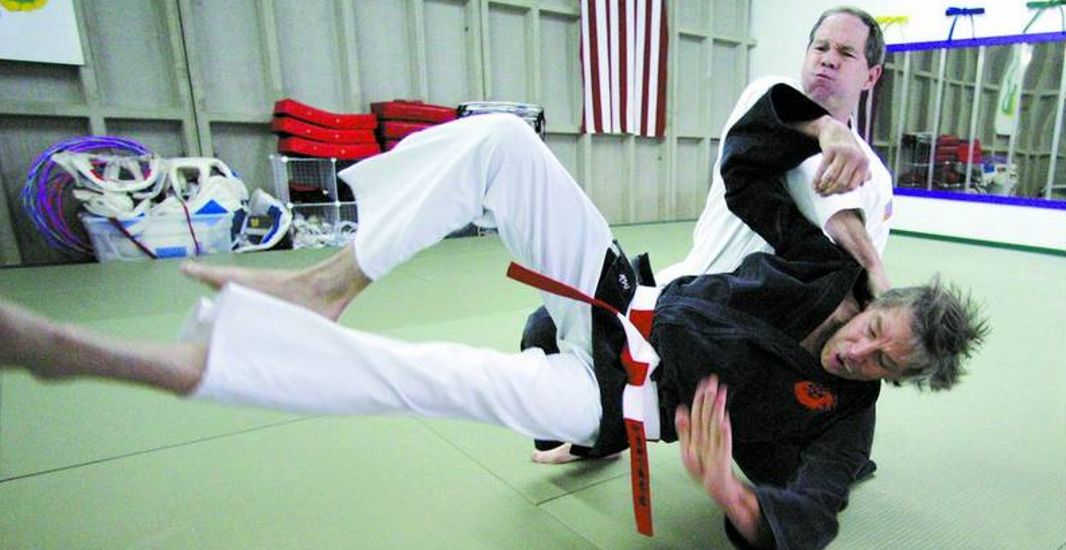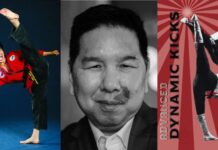The first lesson learned in the art of judo is to off balance your opponent in order to execute a throw. This method is called kuzushi, and there are eight directions in which a person can be pushed and or pulled to accomplish “off balancing.”
 Since judo is considered a sport, kuzushi is achieved without injuring your opponent. In the Japanese art of Shinto Yoshin Ryu Jiu-Jitsu, strikes and kicks are often employed as a form of kuzushi. A much more lethal method of taking an opponent off balance, these karate techniques are used to win a fight in the street whereas judo kuzushi is used to win trophies and ribbons. This in no way diminishes the effectiveness of traditional judo as a self-defense, it is just that jiu-jitsu was created for combat and all of the subsequent techniques were designed to kill or maim an attacker.
Since judo is considered a sport, kuzushi is achieved without injuring your opponent. In the Japanese art of Shinto Yoshin Ryu Jiu-Jitsu, strikes and kicks are often employed as a form of kuzushi. A much more lethal method of taking an opponent off balance, these karate techniques are used to win a fight in the street whereas judo kuzushi is used to win trophies and ribbons. This in no way diminishes the effectiveness of traditional judo as a self-defense, it is just that jiu-jitsu was created for combat and all of the subsequent techniques were designed to kill or maim an attacker.
Although Shinto Yoshin Ryu is one of the oldest systems in the martial arts, there are only 40 plus of schools in the United States that teach this combination of karate and throwing techniques. One such dojo is Sierra Jujitsu and Karate in Carson City Nevada.
“Our system is a Japanese based style of jujitsu that focuses heavily on blocking and striking before doing anything else,” says 7th degree black belt John Chatwood. Many other styles will practice their nage (throwing) and their mat work from a defensive posture. While other styles practice their kuzushi by extending their opponents balance, we believe in destroying that person’s balance. We want to hit them as hard as we can, numerous times before doing a throw, takedown or armbar.”
An example of a Shinto Yoshin technique is if an attacker were to throw a punch, Chatwood would use a low block, winding the blow to the outside, then he would step inside and deliver an elbow strike to his opponents ribs, taking away their balance and air. Next, Chatwood swiftly moves to the rear of the attacker, grabbing the collar and throwing him backward over a bent knee.
“I like this move because the attacker has no idea of where he’s going,” says Chatwood. “Then we allow for the hardest hit there is; he hits the ground. I then follow him to the ground with an armbar or another appropriate submission techniques.”
As in any form of fighting the ability to “set up” your opponent for an attack is paramount to success. In Shinto Yoshin Ryu Chatwood employs the strategy of countering an attack to set up his offence.
“What we do is sort of a counter art,” says Chatwood. “Although we do have numerous first strikes, I like to wait until the opponent makes a move, which commits his balance, then we’ll move inside. We don’t stay to the outside like many other styles of jujitsu or karate. We believe in staying very close to our opponent. However on that inside move we do use a strike, or kick to take away their balance as we move in for a throw.”
In watching Chatwood and his students go through their workout it’s obvious that their forms, strikes and kicks have a strong Japanese base. In fact, Shinto Yoshin Ryu is the foundation for one of the oldest of the martial arts.
“From Shinto Yoshin Jiu-Jitsu came Wado-Ryu karate,” says Chatwood. “So this is one of the rare cases where a karate style can trace its lineage directly back to a jujitsu system. We have stayed true to the jujitsu principles of the art because we like the ‘tools’ that it gives us to work with.”
Like all good karate systems, hands set up the feet, and feet set up the hands in free fighting. This adage is also true in setting up a Shinto Yoshin Ryu Jiu-Jitsu attack.
“We’ll use a number of kicks, but we don’t do a lot of high head-hunter type of kicks,” Chatwood explains. “Our focus is more on a low, roundhouse kick against the outside of the thigh or lower calf. Foot sweeps are also an important of our set ups, we’ll also use a very fast snap kick to the groin and inside of the thigh to attack and off balance our opponents.”
When a roundhouse kick is used against a Shinto Yoshin stylist, Chatwood likes to counter by stepping inside of the attack using a punch, or elbow strike to counter the attack.
“If someone throws a back leg, snap kick we’ll move off to the side, grab the leg, extending it out and help our opponent drop down to the splits,” Chatwood says with an impish grin.
Free fighting takes on a different attitude at Chatwood’s dojo. The blend of karate kumite, judo, and jujitsu makes for some interesting sparring sessions.
“We do kumite, but we do jujitsu kumite,” Chatwood explains. “We start off in a very regimented program with a limited amount of actual sparring. As their skills improve I’ll increase their degree of contact. Then after they achieve a green belt level of training we’ll introduce a handful of takedowns and sweeps. Eventually our students will be encourage to get inside their opponent, execute throws, sweeps, and takedowns and into a mat hold after doing a striking or kicking entry.”
One of the training procedures incorporated into Chatwood’s program is a high regard for control and safety. The person executing the throw is responsible for the safety of the individual he or she is throwing. Subsequently the student must have perfect “control” of their counter (none to light contact with strikes and kicks) and they must have total control of the throw to insure that their attacker lands properly.
Another unique aspect of Chatwood’s training is his warm ups. In true Shinto Yoshin Ryu fashion he has included both karate, judo and jujitsu techniques into his pre workout program.
“Our warm ups are sort of interesting,” says Chatwood. “All of our exercises have been developed around the hardest exercises I know of and that’s having a person pick up his or her own body weight a number of times. For example, we’ll combine a roundhouse kick stretch, with a kicking technique, and a side fall. We start by executing a back leg round house kick, spinning around then dropping into a side fall then quickly getting back up and doing it again on the opposite side. Then we’ll do back leg snap kicks, a double punch, while holding the leg up in the air, then go into a judo roll. This way we have a warm up that employs kicks, punches, falls, and tumbling.”
Chatwood is a firm believer in the power of cross training. The success of blending a striking art with a throwing art develops a well-rounded martial artist. It is this “flexibility” in thinking that sets Shinto Yoshin Ryu apart from other systems.
“One of the strong advantages of cross training is that we prevent injuries,” says Chatwood. “When a person is cross training they’re not over working just one part of their body. They’re not constantly getting their body pounded into the mat, or extending their joints with constant kicking and punching. It takes longer to learn our system because of all the different techniques that we employ but they (students) pick up such a broad base of knowledge that I find I have a group of very talented students and a much lower injury rate.”
Chatwood has also created some entertaining training tools to keep the youngsters interested in developing their martial arts skills. One of the drills the kids love is when Chatwood pulls out his bubble gun. It shoots soap bubbles into the air and his young students do their best to bust them with a variety of kicks and punches.
“They’ll throw more kicks and punches in one minute getting at those bubbles than they would ever do training by themselves,” says Chatwood. “Another drill we do is to take a wooden boken and stab (gently) at them and they do backward & forward rolls to avoid contact. It’s a game to them, but at the same time they’re gaining knowledge and improving their skills.”
One of the important skills in jujitsu is the ability to handle yourself on the ground. At Sierra Nevada Jujitsu groundwork is all part of the principles taught as part of the Shinto Yoshin Ryu system.
“Ground work is very important,” says Chatwood. “In so many fights the confrontation ends up on the ground. That’s why we stress arm bars from a number of positions. I tell my students, “any armbar they can put on a person standing they can put on them on the ground. We teach wristlocks: a smaller person with this technique can easily subdue a stronger person. There are also a variety of chokes and submission holds we use that are common to judo, plus we’ll add strikes and knee attacks on the ground.”
Professor Chatwood began his career in 1979 under Master Douglas Grose, 9th Degree Black Belt, and head of Shinto Yoshin Ryu in the United States, the American Jiu-Jitsu and Karate Association (AJKA). In addition to his jujitsu training Chatwood cross-trained in Shuri Ryu Karate, Tae Kwon-Do, and Dan Zan Ryu Jujitsu, earning a black belt in each system.
“Master Grose was kind enough to promote me regional director for Shinto Yoshin Ryu in the northwestern part of the United States. He also bestowed the rank of Menkyo (formal masters teaching certificate) and he expects me to continue in his footsteps which I will humbly attempt to do.”
While passing on the lessons of his teachers, Chatwood will stay true to the creed of Shinto Yoshin Ryu, “Jiu-jitsu translates to, ‘the gentle art,’ and people think that the gentle art is the techniques themselves. One of the things we teach in Shinto Yoshin Ryu Jiu-Jitsu is that it is the motions that are gentle however the techniques are totally devastating.”
Professor Chatwood is also the Treasurer of the United States Ju-Jitsu Federation, which is the recognized United States governing board of jujitsu for the World Games.
Professor Chatwood can be contacted at: Sierra Jujitsu & Karate – 3170 Research Way # 82, Carson City, NV 89706 – Carson City, NV 89703 – or at 775-882-8821.





